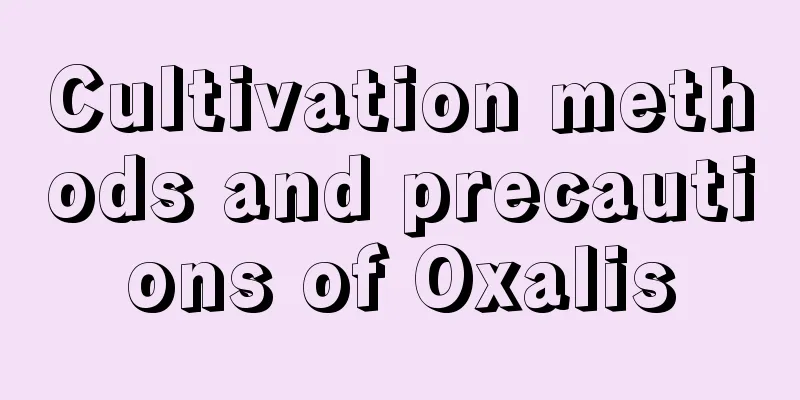Cultivation methods and precautions of Oxalis

1. Maintenance methods1. Temperature: Oxalis likes warmth. Specifically, the temperature between fifteen and twenty-five degrees is more suitable for its growth. It is not very cold-resistant, so try to move it indoors in winter. Try to keep it above ten degrees. 2. Light: It is a plant that likes light. During its growth stage, it needs to be placed in a sunny location. In the hot summer when the light is very strong, it can be moved to a semi-shaded position or provided with appropriate shade. 3. Watering: Oxalis is a moisture-loving plant, but it is also afraid of waterlogging. Therefore, when it is growing vigorously, you can water it every two or three days. However, water must not accumulate. When there is too much rain, flood prevention is also needed. In winter, just keep the soil in the pot from completely drying out. 4. Soil: The main requirements are nutrition, air permeability, drainage, etc. It is best to choose soil that is rich in humus and loose. 2. Breeding techniques1. Repotting: The soil of potted plants can be changed every two or three years. During this period, you can also loosen the soil from time to time. Sandy soil can be selected as the new soil, and river sand, base fertilizer, etc. can be mixed in. After changing it, water it slightly and then place it in a place with suitable temperature and no strong light. 2. Reproduction: The main method used is sowing. Choose a place with deep soil, good drainage and a certain slope as the sowing site. Before sowing, you need to apply some organic fertilizer to the soil and mix it evenly. Then, it’s time to choose the seeds. Plump seeds without diseases or insects are the most suitable. After that, you can officially start sowing. The spacing can be controlled at about fifteen centimeters. After sowing, water thoroughly and they will germinate quickly. 3. Problem diagnosis and treatment1. Disease: In summer, powdery mildew is more likely to occur, especially when ventilation and light conditions are poor. This disease can cause leaves to rot and even fall off in large areas. Treatment is with thiophanate methyl. 2. Pests: Pests mainly appear in May, mainly "red spiders". Because its leaves are relatively dense, prevention and control are difficult and require spraying of pesticides. IV. Other issues1. Toxicity: It is a non-toxic plant and can be grown with confidence. In addition, it can also be used as food. 2. Can it be raised at home?: It has good ornamental value and is suitable to be kept at home. It should be placed in a well-lit place. |
>>: Cycad cultivation methods and precautions
Recommend
The breeding methods and precautions of Hongyun Dangtou
1. Breeding methods 1. Soil: It prefers loose, br...
When and how to repot gardenia
Gardenia repotting time It is recommended to repo...
How many days will it take for the leaves of potted plants to wilt after repotting? What should I do if the leaves of potted plants wilt after repotting?
Growing flowers and plants is one of people's...
The 10 best plants to grow in the office
Pothos There are many varieties of green radish, ...
Can coriander be sown in winter?
Coriander is grown throughout my country. It is s...
Poplar growth environment conditions and characteristics
Poplar Growth Environment Conditions and Requirem...
How to fertilize colorful pineapple
The need for fertilizer Let’s talk about the soil...
Difference Between Clover and Oxalis
1. Different plant types Trifolium, also known as...
Are bayberry trees self-pollinating?
1. Is it self-pollination? Bayberry trees are div...
When is the best time to harvest onions?
Green onion is a very common vegetable and a very...
Can Gardenia remove formaldehyde?
1. Little effect Gardenia has basically no effect...
Breeding methods and precautions of tortoise shell dragon
1. Breeding methods 1. Soil: It is tolerant to ba...
How to prune lucky bamboo
1. Prune yellow leaves During its growth process,...
The difference between white magnolia and white orchid
The difference of flowers Although both white mag...
What soil substrate should be used for growing Dendrobium?
The soil environment in which Dendrobium grows is...









